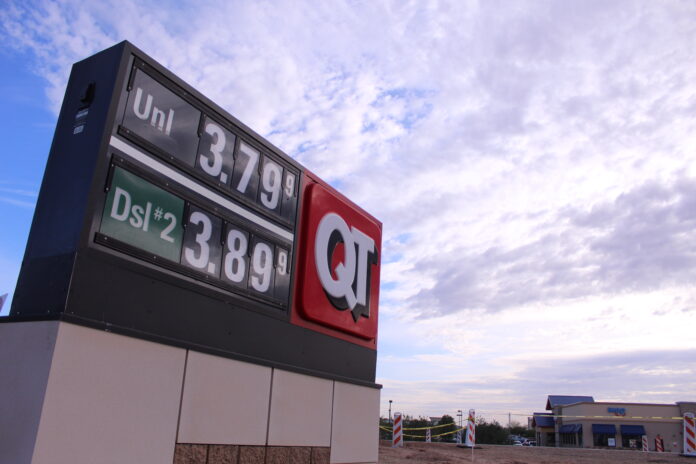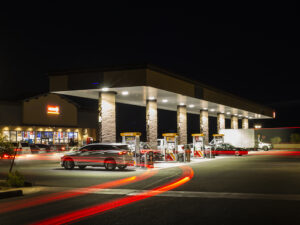
The price of gas has shot up by at least 50 cents a gallon in and around Maricopa in the last month.
Arizona’s average price right now is $3.74 per gallon. That’s more than 30 cents higher than the national average of $3.41.
That spike has influenced Maricopans in their spending and travel habits. On facebook, InMaricopa reached out to followers to get their opinion on the hike. The reactions were varied.
Ryan Hosner said that he and his friends coordinate their long-distance trips.
“My friends and family have teamed together when we go out of town for groceries and supplies in an effort to conserve,” Hosner said. “We reach out to each other via group text and ask if anyone needs anything so we can bring it back home. Saves a lot of gas and time.”
Tommy Borquez pointed out that the timing of the price increase was particularly painful.
“Everyone has their normal driving obligations, so a majority of travel plans stay the same,” he said. “This is just putting more stress financially on Americans and their families while going through a pandemic.”
Other commenters blamed President Joe Biden for the increase while others defended the president.
One woman, Jamie Morano, wished for the day that teleportation becomes a possibility.
Everyone has their opinions about the price increase and why it’s happening, but what are the market forces behind the price spike?
Aldo Vazquez, a spokesperson with AAA Mountain West, an advocate group for travelers that closely watches energy prices and trends, pointed out that despite what’s going on in Arizona, the prices are stabilizing in other parts of the country.
“Nationally, while the prices are higher now than this time last year, the prices are down a little bit,” Vazquez said. “They’re down one cent from last week and two cents lower than a month ago.”
Both nationally and locally, the spike has come during an odd time of the year. Normally, as the national gas formula changes from the summer blend to the winter blend, the prices drop.
This year, not so much.
Vazquez explained that while normally relief arrives at the pump during the winter months, that’s not the case this year as the country rebounds from the shutdowns of COVID-19 pandemic.

“The prices were lower last year due mainly to the fact that the demand fell through the floor,” Vazquez said. “This year, as the economy has started to rebound, we’ve seen the demand rise and the price has increased.”
Vasquez pointed out that, geographically, gas prices differ in each part of the country, due mainly to availability, local taxes and transportation costs.
“In the south, you’re going to have lower prices because there’s more refineries and oil production and there’s less transportation costs,” Vasquez said. “In Arizona, we have gas coming in from New Mexico and gas coming in from California. There are no refineries in Arizona and the cost of trucking it in figures into that price.”
There’s also scarcity caused by availability of product, which is a result of the number of oil refineries that produce auto fuel. The Oil and Gas Journal keeps up with these numbers worldwide.
According to their 2020 report, California has only nine refineries that process more than 100,000 barrels of oil per day. New Mexico only has one refinery and it processes 105,000 barrels a day.
Conversely, Louisiana has 10 refineries that process more than 100,000 barrels of oil per day. Texas has 19.
With fewer refineries available to meet demand, the gas prices are always going to be higher on the west Coast. California’s average price is $4.70 per gallon.
While transportation costs and refinery capacity may figure in heavily to the local price of gas, the main component of the price of gas is goes back to the price of a barrel of oil.
Right now, the price of oil is hovering around $80 per barrel. In August, it was around $60 per barrel. It’s nearly hit $85 per barrel twice, once on Oct. 26 and again on November 2.
“We’re going to continue to see the same price fluctuations along if it stays where it is now,” Vazquez said of the price of oil. “It’s going to have to get down to $75 per barrel for things to stabilize.”
Vazquez added that while prices have increased of the last year, it’s not yet reached a level higher than it was pre-pandemic.
“What we’re seeing is prices are getting back to what we saw before the pandemic,” Vazquez said. “There was more of a demand for it then. Things are getting back to normal.”
In the last week, there were stories in the news of how the federal government was going to release oil from its strategic reserves to lower prices. The price dipped into the mid-70s for a day or two before climbing back to the $80 range.
Vazquez said that AAA didn’t yet have enough details on the release to make a statement on it.

![3 things to know about the new city budget Vice Mayor Amber Liermann and Councilmember Eric Goettl review parts of the city's 2024 operational budget with Mayor Nancy Smith on April 24, 2024. [Monica D. Spencer]](https://www.inmaricopa.com/wp-content/uploads/2024/04/spencer-042424-preliminary-budget-meeting-web-218x150.jpg)






![MHS G.O.A.T. a ‘rookie sleeper’ in NFL draft Arizona Wildcats wide receiver Jacob Cowing speaks to the press after a practice Aug. 11, 2023. [Bryan Mordt]](https://www.inmaricopa.com/wp-content/uploads/2024/04/cowing-overlay-3-218x150.png)



![Alleged car thief released without charges Phoenix police stop a stolen vehicle on April 20, 2024. [Facebook]](https://www.inmaricopa.com/wp-content/uploads/2024/04/IMG_5040-218x150.jpg)

![3 things to know about the new city budget Vice Mayor Amber Liermann and Councilmember Eric Goettl review parts of the city's 2024 operational budget with Mayor Nancy Smith on April 24, 2024. [Monica D. Spencer]](https://www.inmaricopa.com/wp-content/uploads/2024/04/spencer-042424-preliminary-budget-meeting-web-100x70.jpg)


